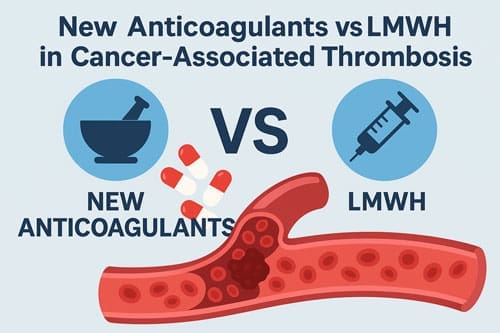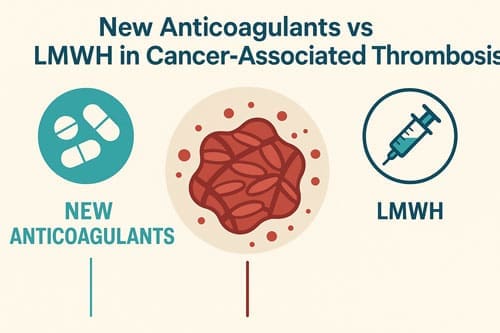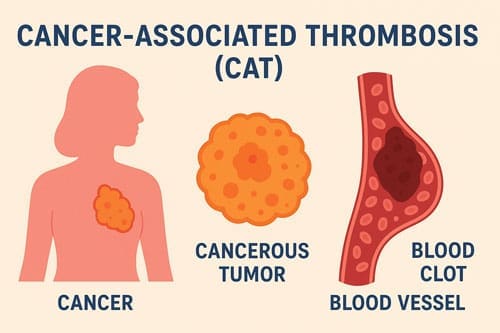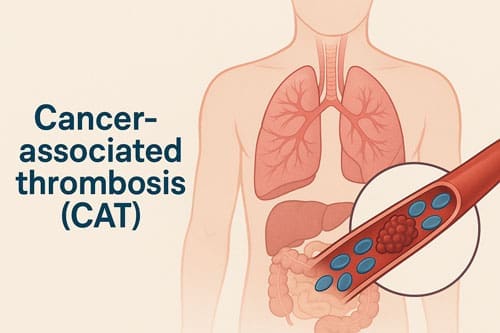New Anticoagulants vs LMWH in Cancer-Associated Thrombosis: Latest Evidence
Please like and subscribe if you enjoyed this video 🙂
Introduction
Venous thromboembolism (VTE), encompassing deep vein thrombosis and pulmonary embolism, remains one of the most common and life-threatening complications in patients with cancer. It is not only a marker of advanced malignancy and systemic inflammation but also a leading cause of death in this population. Despite advances in oncology care, the management of cancer-associated thrombosis (CAT) continues to present major clinical challenges.
The risk of developing VTE is notably elevated in cancer patients due to multiple factors, including tumor-related hypercoagulability, chemotherapy, central venous catheters, immobility, and surgical interventions. Even after completing anticoagulant therapy, the threat persists. Evidence suggests that up to 20% of patients experience recurrent VTE within 12 months of discontinuation, and the case fatality rate associated with such events is approximately 14.8% (95% CI: 6.6–30.1). This highlights the importance of carefully balancing long-term prevention with safety.
Historically, low molecular weight heparins (LMWH) have served as the cornerstone of treatment for cancer-associated thrombosis. Their predictable pharmacokinetics and lower bleeding risk made them preferable to vitamin K antagonists, particularly in patients with fluctuating nutritional status or drug-drug interactions.
The pivotal CLOT trial demonstrated the superiority of dalteparin, an LMWH, over warfarin in reducing the risk of VTE recurrence among cancer patients. Dalteparin reduced VTE recurrence by nearly half (relative risk 0.51; 95% CI: 0.33–0.79), helping to establish LMWHs as the gold standard for years.
However, LMWH therapy poses practical challenges—namely, daily subcutaneous injections, which can be painful, burdensome, and limit adherence, particularly during long-term use.
Additionally, the SELECT-D trial found that rivaroxaban was associated with a 4% recurrence rate at 6 months compared to 11% for dalteparin (HR 0.43, 95% CI: 0.19-0.99), while the HOKUSAI VTE Cancer trial reported a 7.9% recurrence rate for edoxaban versus 11.3% for dalteparin.
Despite their benefits, DOACs come with an increased risk of bleeding, particularly in patients with certain tumor types. Meta-analyses have shown that DOACs are associated with a 74% higher risk of major bleeding compared to LMWH (RR 1.74; 95% CI: 1.05–2.88).
Furthermore, the 12-month cumulative incidence of major bleeding in cancer patients treated with anticoagulants is estimated at 12.4% (95% CI: 6.5–18.2). This risk is not uniform, patients with gastrointestinal or genitourinary cancers, such as colorectal, pancreatic, or prostate cancer, are particularly vulnerable to bleeding complications with DOACs.
Thus, while DOACs may reduce the recurrence of VTE more effectively than LMWHs, the benefit-risk ratio must be evaluated carefully, taking into account the patient’s type of cancer, location of metastases, renal function, thrombocytopenia, and potential drug interactions.
This article examines the latest evidence comparing new oral anticoagulants with LMWH for cancer-associated thrombosis. Through analysis of key clinical trials and current guidelines, including those from the National Comprehensive Cancer Network, we will explore how to optimize anticoagulant selection based on individual patient factors and cancer characteristics.

Understanding Cancer-Associated Thrombosis and Treatment Goals
Cancer-associated thrombosis (CAT) remains one of the most challenging complications in oncology and hematology practice. Patients with malignancies are uniquely vulnerable to both venous thromboembolism (VTE) and bleeding events, making anticoagulation management a delicate balancing act. The dynamic interplay between prothrombotic states induced by cancer and the heightened risk of hemorrhage, often exacerbated by treatment, demands a personalized, risk-adapted approach to therapy.
VTE recurrence and bleeding risk in oncology patients
VTE is more than an acute event in cancer patients, it’s a chronic risk with serious prognostic implications. Despite appropriate anticoagulation, individuals with cancer face a markedly elevated risk of recurrence, far exceeding that seen in non-cancer populations. Alarmingly, thromboembolic events are the second leading cause of death in cancer patients, following only disease progression.
Risk of recurrence is not uniform and is influenced by tumor type, stage, and clinical status. Cancers associated with the highest VTE recurrence rates include:
- Primary brain tumors
- Lung and ovarian malignancies
- Advanced pancreatic cancer (especially stage IV)
- Myeloproliferative and myelodysplastic syndromes
- Progressive or metastatic solid tumors
- Neurologic impairment (e.g., leg paresis)
The recurrence risk is also time-dependent, with the first six months representing the period of greatest vulnerability, recurrence rates reach 22.1 per 100 person-years, before decreasing to 7.9 per 100 person-years between months 6 and 12.
Equally concerning is the elevated bleeding risk in patients with cancer, which persists even in the absence of anticoagulation. Over a 12-month period, studies report:
- Clinically relevant bleeding in 16.6% of anticoagulated cancer patients
- Major bleeding in 9.1%
- Among those not receiving anticoagulation, rates remain substantial at 14.4% and 7.0%, respectively
Bleeding risk is highly dependent on tumor location and associated treatments. The most frequent bleeding sites include:
- Gastrointestinal tract (57.2%)
- Genitourinary tract (20.2%)
- Intracranial hemorrhage (10.4%)
Cancers of the head and neck are particularly notorious for bleeding complications, especially in the setting of radiation therapy, tumor invasion, or mucosal friability.
Therapeutic objectives: balancing efficacy and safety
Given the competing risks of recurrent VTE and major bleeding, the cornerstone of CAT management is to balance anticoagulation efficacy with bleeding safety. Previously, low-molecular-weight heparin (LMWH) was the preferred treatment for cancer-associated thrombosis. Clinical trials established its superiority over vitamin K antagonists (e.g., warfarin) in reducing VTE recurrence without markedly increasing bleeding risk.
However, LMWH therapy has notable limitations:
- Requires daily subcutaneous injections
- High cost impacts accessibility and adherence
- Treatment fatigue often leads to early discontinuation
These barriers have paved the way for direct oral anticoagulants (DOACs) such as edoxaban, apixaban, and rivaroxaban, which offer oral administration, fixed dosing, and no routine monitoring, making them more attractive in routine cancer care.
When determining an appropriate anticoagulation strategy, clinicians must carefully weigh multiple factors. For patients with severe thrombocytopenia, guidelines suggest full-dose anticoagulation for platelet counts above 50 G/L, temporary withholding for counts below 25 G/L, and resumption at full dose when counts exceed 50 G/L. Furthermore, drug-drug interactions and gastrointestinal symptoms like nausea and vomiting, common in cancer patients, may affect DOAC bioavailability.
Regarding treatment duration, current evidence supports anticoagulation for at least 6 months in cancer-associated thrombosis. Extended anticoagulation beyond this period appears warranted in patients with ongoing active malignancy, particularly those with metastatic disease or continuing antineoplastic therapy. At this juncture, the risk-benefit ratio should undergo periodic reassessment.
Secondary prophylaxis with warfarin has demonstrated a notable impact, reducing the hazard of VTE recurrence by approximately 60%. Yet, the median duration of warfarin anticoagulation often remains brief (79 days) due to poor patient survival.

Patient-Centered Criteria for Anticoagulant Selection
Selecting appropriate anticoagulant therapy in patients with cancer requires thorough assessment of individual risk factors. Several patient-specific characteristics must inform clinical decision-making to optimize outcomes and minimize complications.
Renal function thresholds for DOAC eligibility
Renal function fundamentally impacts direct oral anticoagulant (DOAC) selection, as all these agents undergo kidney elimination to varying degrees. Dabigatran exhibits the highest renal clearance (80%), followed by edoxaban (50%), rivaroxaban (35%), apixaban (27%), and betrixaban (11%). First and foremost, clinicians must assess patient renal function using the Cockcroft-Gault equation before initiating therapy and monitor it at least annually thereafter.
Current guidelines advise dose adjustment based on creatinine clearance, with alternative anticoagulation recommended for progressive renal impairment. Notably, phase III trials excluded patients with severe renal dysfunction (CrCl <30 mL/min) or dialysis. In patients with severe kidney impairment, apixaban may represent a safer option given its minimal renal clearance. Unfortunately, inappropriate DOAC dosing occurs in up to 32% of patients, primarily through subtherapeutic dosing in renal insufficiency.
Impact of gastrointestinal and genitourinary cancers on bleeding risk
Gastrointestinal (GI) and genitourinary (GU) malignancies present heightened bleeding concerns with anticoagulation. Several major randomized trials, including HOKUSAI-VTE, SELECT-D, and ADAM-VTE, identified these populations as having elevated bleeding risk. The GI system appears particularly susceptible to hemorrhage due to its rich intra- and submucosal blood supply and high cell turnover.
Upper GI cancer specifically correlates with substantially higher major bleeding rates compared to non-GI malignancies (22.4% vs. 11.6% 5-year cumulative incidence). Among upper GI cancer patients experiencing major bleeding, most events (53%) originate from the upper GI tract itself, followed by lower GI sites (24%). Furthermore, DOACs may exert direct anticoagulant effects topically in the GI tract, unlike vitamin K antagonists.
Given these findings, guidelines typically recommend low-molecular-weight heparin (LMWH) over DOACs for patients with luminal GI cancers, actively bleeding GU malignancies, or those with mucosal abnormalities such as duodenal ulcers, gastritis/esophagitis, or colitis. Nevertheless, apixaban appears potentially safer than rivaroxaban in this population, with one study documenting lower major bleeding rates (3.4% vs. 8.5%) and clinically relevant non-major bleeding (2.2% vs. 7.6%).
Considerations in patients with brain metastases or thrombocytopenia
Approximately one in five patients with brain metastases develop venous thromboembolism. Traditionally, clinicians have withheld anticoagulation in this population due to intracranial hemorrhage concerns. In contrast, recent evidence suggests LMWH can be administered without increasing intracranial bleeding likelihood in most cases.
The primary exception involves tumors with inherently high spontaneous bleeding tendencies. Specifically, melanoma and renal cell carcinoma brain metastases consistently demonstrate elevated intracranial hemorrhage risk. For these patients, alternative strategies such as inferior vena cava filter placement might be warranted initially before considering anticoagulation.
Thrombocytopenia presents another common challenge, affecting up to 50% of patients receiving certain chemotherapies like gemcitabine and platinum agents. Guidelines recommend full-dose anticoagulation for platelet counts above 50,000/μL, reduced dosing (typically half-dose LMWH) for counts between 25,000-50,000/μL, and temporary discontinuation when counts fall below 25,000/μL. Interestingly, a recent analysis revealed that the bleeding risk may increase even at platelet counts ≤100,000/μL. Modified-dose strategies (half-dose enoxaparin 0.5 mg/kg every 12 hours) resulted in lower major hemorrhage rates at 60 days (6.6% vs. 12.8%) compared to full-dose regimens.
Comparative Outcomes of DOACs vs LMWH in Clinical Trials
Recent randomized controlled trials have established a growing evidence base for direct oral anticoagulants (DOACs) in cancer-associated thrombosis. These trials provide essential data that inform clinical decision-making between newer anticoagulants and traditional low-molecular-weight heparin (LMWH) therapy.
VTE recurrence rates in SELECT-D, HOKUSAI, and CARAVAGGIO
Multiple vital trials consistently demonstrate superior efficacy of DOACs in preventing recurrent venous thromboembolism (VTE). The SELECT-D trial revealed a 6-month recurrence rate of only 4% with rivaroxaban versus 11% with dalteparin (HR 0.43; 95% CI 0.19-0.99). Similarly, the HOKUSAI-VTE Cancer study found that edoxaban reduced recurrent VTE to 7.9% compared to 11.3% with dalteparin, though this difference did not reach statistical significance (HR 0.71; 95% CI 0.48-1.06). Perhaps most compelling, the CARAVAGGIO trial demonstrated a 5.6% recurrence rate with apixaban versus 7.9% with dalteparin (HR 0.63; 95% CI 0.37-1.07).
Across these studies, a meta-analysis confirms that DOACs remarkably reduce VTE recurrence compared to LMWH (5.2% vs 8.2%; RR 0.62; 95% CI 0.43-0.91). Essentially, this represents a 38% relative risk reduction in recurrent thrombotic events with DOACs.
Major bleeding outcomes stratified by cancer type
Bleeding risks vary substantially by cancer type. Among patients with gastrointestinal malignancies, DOACs generally show higher bleeding tendencies than LMWH (RR 2.30; 95% CI 1.08-4.88). This pattern is especially prominent with rivaroxaban and edoxaban.
Yet apixaban appears to maintain a more favorable safety profile. The CARAVAGGIO trial reported major bleeding rates of 3.8% with apixaban versus 4.0% with dalteparin (HR 0.82; 95% CI 0.40-1.69). Accordingly, this appears to be the only major trial where a DOAC did not increase GI bleeding risk, despite including substantial numbers of patients with gastrointestinal cancers.
Mortality and treatment discontinuation trends
Mortality rates remain comparable between treatment approaches. The meta-analysis of major trials shows virtually identical 6-month mortality rates: 23.9% with DOACs versus 24.2% with LMWH (RR 0.99; 95% CI 0.83-1.18). Thus, survival outcomes appear equivalent regardless of anticoagulant choice.
Nonetheless, treatment discontinuation rates favor DOACs. Patients receiving oral anticoagulants exhibit better adherence with significantly lower discontinuation rates (39.6% vs 45.0%; RR 0.88; 95% CI 0.81-0.96). This improved persistence likely contributes to the enhanced efficacy observed with DOACs, as injection-related barriers are eliminated.
Overall, these findings suggest that new anticoagulants in cancer provide enhanced protection against recurrent thrombosis with acceptable bleeding profiles, especially when considering cancer-specific factors and drug selection.

Materials and Methods: Evidence Synthesis and Risk Stratification
Systematic evaluation of anticoagulant efficacy in cancer patients requires rigorous methodological approaches. This section examines the evidence synthesis methods underlying current clinical recommendations for new anticoagulants in cancer-associated thrombosis.
Inclusion criteria and endpoints in key RCTs
Randomized controlled trials establishing the evidence base primarily enrolled adult patients with objectively confirmed acute venous thromboembolism (VTE) and active cancer. The CARAVAGGIO trial, for instance, included patients with symptomatic or incidental proximal deep-vein thrombosis or pulmonary embolism. Across studies, active cancer typically encompassed solid or hematological malignancies with diagnosis or treatment within preceding 6-24 months or metastatic disease. Studies often stratified randomization according to VTE type (symptomatic/incidental) and cancer diagnosis timing (active/historical).
Primary efficacy endpoints consistently included objectively confirmed recurrent VTE, while safety endpoints encompassed major bleeding according to International Society on Thrombosis and Haemostasis criteria. Major bleeding was uniformly defined as overt bleeding with ≥2g/dL hemoglobin decrease, transfusion of ≥2 units packed red cells, bleeding at critical sites, or fatal bleeding. Secondary outcomes commonly included clinically relevant non-major bleeding, VTE-related mortality, and treatment discontinuation rates.
Meta-analysis methodology and SUCRA ranking interpretation
Methodologically sound meta-analyzes employed comprehensive search strategies across multiple databases (PubMed, Embase, Cochrane Library) with explicit inclusion criteria. Statistical approaches typically utilized random-effects models to account for between-study heterogeneity. The I² statistic quantified heterogeneity, with values >50% indicating substantial variation.
Surface Under the Cumulative Ranking curve (SUCRA) analysis emerged as a valuable method for comparing treatment efficacy and safety. SUCRA values range from 0-100%, with higher values indicating superior treatment performance. For example, apixaban demonstrated highest SUCRA values (81.0%) for efficacy in preventing VTE recurrence, followed by rivaroxaban (73.0%) and edoxaban (65.9%). Conversely, for safety endpoints, SUCRA rankings showed LMWH (73.0%) and apixaban (57.8%) with lowest clinically relevant non-major bleeding risks.
Network meta-analysis frameworks additionally facilitated indirect comparisons between DOACs, with LMWH serving as common comparator.
Limitations in Current Evidence and Clinical Application
Despite promising advances with direct oral anticoagulants (DOACs) in cancer-associated thrombosis, substantial evidence gaps remain that limit definitive clinical recommendations. These limitations warrant careful consideration when interpreting research findings and applying them in practice.
Heterogeneity in cancer definitions across trials
The cancer populations studied across pivotal anticoagulation trials exhibit remarkable heterogeneity that complicates interpretation of results. Most concerning, the definition of “active cancer” varied significantly between studies, with inconsistent timeframes for diagnosis or treatment (ranging from 6-24 months). Furthermore, the methodological heterogeneity extends to:
- Different follow-up periods (from 2.5 months to median 21.4 months across studies)
- Varying proportions of high-risk cancer sites such as brain, gastric, and pancreatic tumors
- Inconsistent inclusion criteria regarding chemotherapy exposure
- Non-uniform VTE definitions and qualifying events
This heterogeneity partially explains the differing event rates observed. Whereas some trials showed lower VTE recurrence and bleeding rates, others demonstrated substantially higher complications, suggesting enrollment of fundamentally different risk populations. The ADAM VTE trial, for instance, demonstrated markedly lower VTE events, bleeding incidents, and mortality compared to HOKUSAI VTE Cancer, SELECT-D, and CARAVAGGIO.
Lack of head-to-head DOAC vs LMWH trials in high-risk subgroups
Yet another critical limitation involves the absence of robust head-to-head trials focusing on high-risk subgroups. Presently, inadequate evidence exists regarding DOAC efficacy and safety in patients with severe renal insufficiency, as phase III trials typically excluded those with creatinine clearance below 30 mL/min. Likewise, people of Asian race or Hispanic ethnicity were poorly represented in major trials.
Additionally, several studies lacked proper blinding, with participants and physicians aware of treatment assignment. This potentially introduced bias in outcome assessment and reporting. The unavailability of data comparing different DOACs directly further complicates clinical decision-making, as apparent differences in bleeding profiles between agents might be trial-specific rather than drug-specific.
Finally, trials have not adequately addressed how to optimize anticoagulation in thrombocytopenic patients, despite thrombocytopenia affecting up to 50% of patients receiving certain chemotherapies. Given these limitations, treatment decisions often require individualizing therapy through multidisciplinary consultation among oncologists, hematologists, cardiologists, and coagulation experts.


Conclusion
The evidence comparing DOACs and LMWH for cancer-associated thrombosis reveals a complex clinical picture that requires nuanced decision-making. Meta-analyzes demonstrate that DOACs reduce VTE recurrence compared to LMWH (5.2% vs 8.2%; RR 0.62; 95% CI 0.43-0.91), representing a 38% relative risk reduction (Young et al., 2018). Nevertheless, this benefit must be weighed against bleeding risks that vary substantially by cancer type and specific agent.
Patients with gastrointestinal malignancies experience higher bleeding tendencies with DOACs than LMWH (RR 2.30; 95% CI 1.08-4.88), particularly with rivaroxaban and edoxaban (Li et al., 2019). Apixaban, however, appears to maintain a more favorable safety profile with comparable major bleeding rates to dalteparin (3.8% vs 4.0%; HR 0.82; 95% CI 0.40-1.69) as demonstrated in the CARAVAGGIO trial (Agnelli et al., 2020).
Patient-specific characteristics undoubtedly influence anticoagulant selection. Renal function serves as a critical determinant, with varying degrees of kidney clearance among DOACs ranging from 11% with betrixaban to 80% with dabigatran. Despite these considerations, treatment discontinuation rates favor DOACs over LMWH (39.6% vs 45.0%; RR 0.88; 95% CI 0.81-0.96), likely reflecting better adherence with oral administration (Mulder et al., 2021).
The landscape of cancer-associated thrombosis management continues to evolve. Though current evidence supports DOACs as effective alternatives to LMWH for most cancer patients, several limitations persist. Heterogeneity in cancer definitions, variable follow-up periods, and inconsistent inclusion criteria across trials complicate direct comparison. Additionally, inadequate evidence exists for high-risk subgroups including patients with severe renal impairment, brain metastases, or thrombocytopenia.
Clinicians should therefore adopt an individualized approach based on cancer type, bleeding risk, renal function, and patient preference. For most patients without gastrointestinal malignancies and with adequate renal function, DOACs offer a convenient and effective option. Conversely, LMWH remains preferable for patients with GI cancers, active GI bleeding, or severe renal impairment. During treatment, regular reassessment of the risk-benefit profile remains essential, especially beyond the initial 6-month period.
Future research must address current evidence gaps through targeted studies in high-risk subgroups and direct DOAC comparisons. Until then, multidisciplinary consultation among oncologists, hematologists, and thrombosis specialists provides the optimal framework for navigating this complex therapeutic landscape. Healthcare professionals should continuously monitor emerging evidence as clinical guidelines for cancer-associated thrombosis management continue to evolve with new research findings.

Frequently Asked Questions:
FAQs
Q1. What are the advantages of direct oral anticoagulants (DOACs) over low molecular weight heparin (LMWH) in cancer patients? DOACs offer several advantages, including reduced VTE recurrence rates, improved patient adherence due to oral administration, and no need for regular blood tests. However, their use should be carefully considered based on individual patient factors and cancer type.
Q2. How does the bleeding risk differ between DOACs and LMWH in cancer-associated thrombosis? Bleeding risk varies depending on cancer type and specific DOAC. Generally, DOACs show higher bleeding tendencies in gastrointestinal cancers. However, apixaban demonstrates a more favorable safety profile with comparable major bleeding rates to LMWH.
Q3. What factors should be considered when choosing an anticoagulant for cancer-associated thrombosis? Key factors include cancer type, bleeding risk, renal function, and patient preference. Gastrointestinal cancers, active GI bleeding, and severe renal impairment may favor LMWH, while most other patients without these risk factors may benefit from DOACs.
Q4. Are DOACs suitable for all cancer patients with thrombosis? No, DOACs are not suitable for all cancer patients. Those with severe renal insufficiency, certain high-risk cancer types (e.g., brain metastases), or severe thrombocytopenia may require alternative anticoagulation strategies or careful monitoring.
Q5. How long should anticoagulation be continued in cancer patients with thrombosis? Current evidence supports anticoagulation for at least 6 months. Extended anticoagulation beyond this period may be warranted in patients with ongoing active malignancy, particularly those with metastatic disease or continuing antineoplastic therapy. Regular reassessment of the risk-benefit ratio is essential.
References:
[1] – https://ashpublications.org/blood/article/122/14/2310/32189/Treatment-of-cancer-associated-thrombosis
[2] – https://ascopubs.org/doi/10.1200/JCO.2023.41.16_suppl.e16323
[3] – https://ashpublications.org/ashclinicalnews/news/2147/Therapeutic-Anticoagulation-Safe-for-Patients-with
[4] – https://www.wikijournalclub.org/wiki/CARAVAGGIO
[5] – https://ashpublications.org/blood/article/116/24/5377/28023/Prediction-of-venous-thromboembolism-in-cancer
[6] – https://www.ahajournals.org/doi/10.1161/JAHA.120.017559
[7] – https://pmc.ncbi.nlm.nih.gov/articles/PMC9529787/
[8] – https://pmc.ncbi.nlm.nih.gov/articles/PMC8267127/
[9] – https://www.sciencedirect.com/science/article/abs/pii/S0953620524001717
[10] – https://www.sciencedirect.com/science/article/pii/S2666572724000117
[11] – https://pmc.ncbi.nlm.nih.gov/articles/PMC5896701/
[12] – https://pmc.ncbi.nlm.nih.gov/articles/PMC8714719/
[13] – https://pmc.ncbi.nlm.nih.gov/articles/PMC11665513/
[14] – https://www.wikijournalclub.org/wiki/SELECT-D
[15] – https://www.nejm.org/doi/full/10.1056/NEJMoa1711948
[16] – https://www.sciencedirect.com/science/article/pii/S2475037922020234
[17] – https://pmc.ncbi.nlm.nih.gov/articles/PMC7292654/
[18] – https://www.ccjm.org/page/acc-2020/caravaggion-findings
[19] – https://www.rpthjournal.org/article/S2475-0379(22)02023-4/abstract
[20] – https://www.nejm.org/doi/full/10.1056/NEJMoa1915103
[21] – https://www.ejves.com/article/S1078-5884(18)30850-5/fulltext
[22] – https://pmc.ncbi.nlm.nih.gov/articles/PMC7311195/
[23] – https://pubmed.ncbi.nlm.nih.gov/36318341/
[24] – https://www.frontiersin.org/journals/cardiovascular-medicine/articles/10.3389/fcvm.2020.586020/full
[25] – https://www.sciencedirect.com/science/article/pii/S2666087320301484
[26] – https://pmc.ncbi.nlm.nih.gov/articles/PMC10265290/
